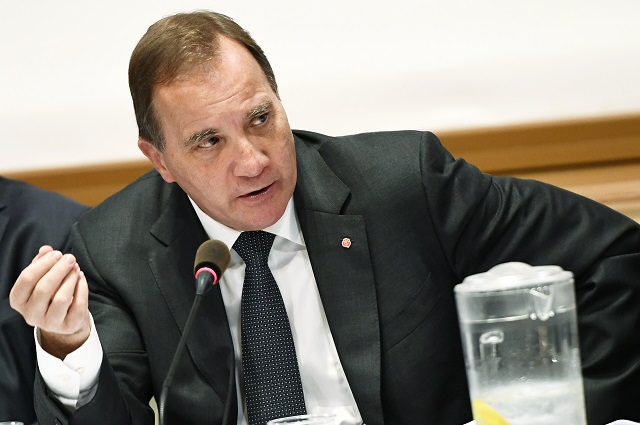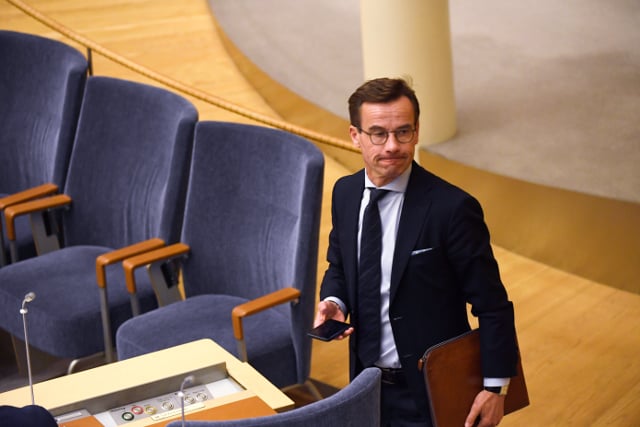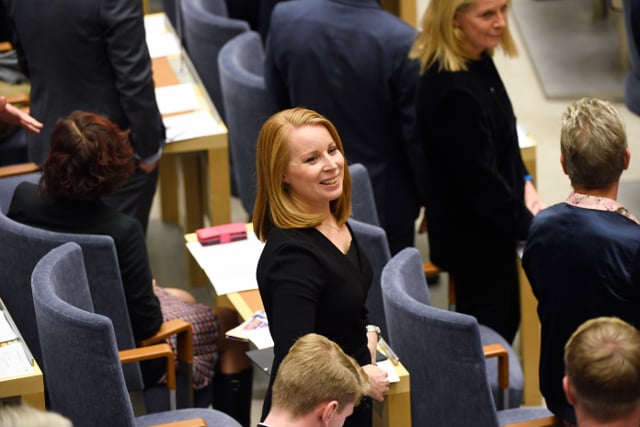Timeline: Everything that's happened in Swedish politics since the elections

It’s no news that Sweden has come to a political deadlock since the September elections. But how did it get there, and why? Here are the most important twists and turns that have taken place since September 9th.
September 9th: Swedish parliamentary elections.
The results are too close to call, but indicate that no one party, and neither the centre-left coalition (Social Democrats, Green Party, Left Party) nor the center-right Alliance (Moderate Party, Liberal Party, Centre Party, Christian Democrats) have won the 175 parliamentary seats needed to form a majority government. Meanwhile, support rises for the far-right Sweden Democrats (SD), albeit not as significantly as some polls had suggested it might do.
Moderate leader Ulf Kristersson demands that incumbent Prime Minister Stefan Löfven steps down, but Löfven wants to await the final election results.
September 10th: Liberal Party leader Jan Björklund announces that he will not work with the SD in any way and that any cooperation with them will end the four-party Alliance.
September 11th: The Social Democrats contact all parties except the SD to try to find a solution to the political deadlock.
September 12th: The four-party Alliance invites Social Democrat leader Löfven to propose a centre-right-led government with cross-border cooperation with the Social Democrats. Löfven rejects the proposal.

Incumbent Prime Minister and Social Democrat leader Stefan Löfven. Photo: Henrik Montgomery / TT
September 13th: Preliminary election results (yes, four days after the election the results are still only preliminary) show that the centre-left coalition has won 144 parliamentary seats, and the center-right Alliance 143. The SD have 62.
September 16th: An election result recount confirms the preliminary results. Both coalition blocks claim to have "won”, but the result is deadlock.
September 21st: The Alliance proposes Moderate Party member Andreas Norlén as parliamentary speaker to replace the incumbent speaker Urban Ahlin of the Social Democrats, while the Social Democrats proposes its own Åsa Lindestam.
September 24th: With the support from the SD, the Moderate Party's Norlén is elected to the post as parliamentary speaker.
September 25th: The parliament votes to remove Löfven from the prime minister post. SD joins the Alliance in voting him down.
Löfven hands in his resignation but the speaker asks him to stay on as prime minister in a caretaker government.
SWEDEN IN FOCUS: How did the political situation get to where it is today?
October 2nd: The parliamentary speaker names Moderates leader Kristersson as 'sonderingsperson'. This means he has the task of holding talks with other party leaders to try to form a government proposal that will be supported by parliament.
October 14th: Kristersson abandons his bid to create an Alliance government after failing to garner enough support.
October 15th: Löfven is given the task of forming a government.
October 29th: Löfven abandons his bid to form a government.
November 5th: Kristersson is given another shot to try to form a government.
The parliamentary speaker announces that he will also be proposed as a candidate to the prime minister post, effectively forcing the parties to make a concrete decision after two months in which no-one has budged on their position.

Moderate Party leader Ulf Kristersson. Photo: Pontus Lundahl/TT
November 14th: Kristersson is rejected as prime ministerial candidate by a parliamentary vote.
Both the Liberal Party and the Centre Party vote against him, despite being members of the Alliance alongside Kristersson's Moderates. They say this is because the government would have also needed support from the SD to succeed, and they have pledged to prevent the SD from gaining influence in Sweden's next government.
November 15th: Centre Party leader Annie Lööf is given the task to act as sonderingsperson to try to break the political deadlock.

Centre Party leader Annie Lööf in parliament. Photo: Pontus Lundahl/TT
November 22nd: Lööf abandons her attempts to find a cross-block compromise. She says she looked into three alternatives: the Alliance working with the Social Democrats, the Alliance working with the Green Party, and a minority centrist government made up of the Centre Party and Liberals. None of the these had enough support, and Lööf also says she doesn't see any possibility of leading a minority government herself.
"It is now up to the speaker to decide on the next step," she says.
November 27th: Lööf says the Centre Party is open to the idea of Löfven returning to the PM post, but only if he will commit to a series of demands that would move his party to the right.
November 28th: The Liberals make a similar announcement, but party leader Björklund does not have the full support of his troops. Löfven responds to the overtures from the Centre Party and Liberals by saying he is ready to enter into a process of "give and take".
A vote on installing Löfven as PM is scheduled for December 5th.
December 3rd: The vote on Löfven is delayed with the speaker giving him more time to try to form a government. No set date is given for the rescheduled vote.
December 10th: The Centre Party said that after working "day and night" to reach a compromise with the Social Democrats, it had decided to vote no to a government led by Löfven.
December 12th: Löfven is formally nominated as PM, and will try to form a government between the Social Democrats and Green Party. The vote is scheduled for December 14th.
December 13th: Parliament rejects the budget put forward by the caretaker government, and the budget proposal from the Moderates and Christian Democrats wins a majority of votes.
Although it's possible to make some changes to the budget in spring, certain decisions such as changes to income tax are fixed for a year, so the result is a blow to the centre-left.
December 14th: Stefan Löfven is rejected by parliament in the vote on his candidacy as PM, and the speaker.
January 10th: Stefan Löfven and Ulf Kristersson meet the speaker to present their final reports. Both are tight-lipped when speaking to media afterwards, but say talks have been "constructive" and are "ongoing".
January 11th: A deal between the Social Democrats, Green Party, Centre Party and Liberal Party is reported by Swedish media and later confirmed by the parties involved. It would see a Social Democrat-Green Party government with backing from the two former opposition rivals.
January 13th: Over the weekend, the party boards of the the four parties involved approve the deal. But even with the backing of all these four parties, it requires support from the Left Party's 28 MPs in order to be passed by parliament.
January 14th: Sweden's Left Party leader Jonas Sjöstedt says his party will not support the government agreement "if the situation remains unchanged". His party is explicitly excluded from political influence by the deal. Parliamentary speaker Andreas Norlén, who had earlier said he would announce the next prime minister candidate on this day, gives the parties another 48 hours for talks.
FOR MEMBERS: Who's running the country? Your questions about the Swedish election
January 16th: Sweden's Left Party decides to abstain in another vote on Stefan Löfven as prime minister after getting reassurance they will not wholly lose their political influence on issues not covered by the four-party deal. This means Löfven has enough votes to become prime minister (again), and parliamentary speaker Andreas Norlén formally nominates him in the Riksdag chamber.
January 18th: Social Democrat leader Stefan Löfven is voted back in as prime minister.
Comments
See Also
September 9th: Swedish parliamentary elections.
The results are too close to call, but indicate that no one party, and neither the centre-left coalition (Social Democrats, Green Party, Left Party) nor the center-right Alliance (Moderate Party, Liberal Party, Centre Party, Christian Democrats) have won the 175 parliamentary seats needed to form a majority government. Meanwhile, support rises for the far-right Sweden Democrats (SD), albeit not as significantly as some polls had suggested it might do.
Moderate leader Ulf Kristersson demands that incumbent Prime Minister Stefan Löfven steps down, but Löfven wants to await the final election results.
September 10th: Liberal Party leader Jan Björklund announces that he will not work with the SD in any way and that any cooperation with them will end the four-party Alliance.
September 11th: The Social Democrats contact all parties except the SD to try to find a solution to the political deadlock.
September 12th: The four-party Alliance invites Social Democrat leader Löfven to propose a centre-right-led government with cross-border cooperation with the Social Democrats. Löfven rejects the proposal.

Incumbent Prime Minister and Social Democrat leader Stefan Löfven. Photo: Henrik Montgomery / TT
September 13th: Preliminary election results (yes, four days after the election the results are still only preliminary) show that the centre-left coalition has won 144 parliamentary seats, and the center-right Alliance 143. The SD have 62.
September 16th: An election result recount confirms the preliminary results. Both coalition blocks claim to have "won”, but the result is deadlock.
September 21st: The Alliance proposes Moderate Party member Andreas Norlén as parliamentary speaker to replace the incumbent speaker Urban Ahlin of the Social Democrats, while the Social Democrats proposes its own Åsa Lindestam.
September 24th: With the support from the SD, the Moderate Party's Norlén is elected to the post as parliamentary speaker.
September 25th: The parliament votes to remove Löfven from the prime minister post. SD joins the Alliance in voting him down.
Löfven hands in his resignation but the speaker asks him to stay on as prime minister in a caretaker government.
SWEDEN IN FOCUS: How did the political situation get to where it is today?
October 2nd: The parliamentary speaker names Moderates leader Kristersson as 'sonderingsperson'. This means he has the task of holding talks with other party leaders to try to form a government proposal that will be supported by parliament.
October 14th: Kristersson abandons his bid to create an Alliance government after failing to garner enough support.
October 15th: Löfven is given the task of forming a government.
October 29th: Löfven abandons his bid to form a government.
November 5th: Kristersson is given another shot to try to form a government.
The parliamentary speaker announces that he will also be proposed as a candidate to the prime minister post, effectively forcing the parties to make a concrete decision after two months in which no-one has budged on their position.

Moderate Party leader Ulf Kristersson. Photo: Pontus Lundahl/TT
November 14th: Kristersson is rejected as prime ministerial candidate by a parliamentary vote.
Both the Liberal Party and the Centre Party vote against him, despite being members of the Alliance alongside Kristersson's Moderates. They say this is because the government would have also needed support from the SD to succeed, and they have pledged to prevent the SD from gaining influence in Sweden's next government.
November 15th: Centre Party leader Annie Lööf is given the task to act as sonderingsperson to try to break the political deadlock.

Centre Party leader Annie Lööf in parliament. Photo: Pontus Lundahl/TT
November 22nd: Lööf abandons her attempts to find a cross-block compromise. She says she looked into three alternatives: the Alliance working with the Social Democrats, the Alliance working with the Green Party, and a minority centrist government made up of the Centre Party and Liberals. None of the these had enough support, and Lööf also says she doesn't see any possibility of leading a minority government herself.
"It is now up to the speaker to decide on the next step," she says.
November 27th: Lööf says the Centre Party is open to the idea of Löfven returning to the PM post, but only if he will commit to a series of demands that would move his party to the right.
November 28th: The Liberals make a similar announcement, but party leader Björklund does not have the full support of his troops. Löfven responds to the overtures from the Centre Party and Liberals by saying he is ready to enter into a process of "give and take".
A vote on installing Löfven as PM is scheduled for December 5th.
December 3rd: The vote on Löfven is delayed with the speaker giving him more time to try to form a government. No set date is given for the rescheduled vote.
December 10th: The Centre Party said that after working "day and night" to reach a compromise with the Social Democrats, it had decided to vote no to a government led by Löfven.
December 12th: Löfven is formally nominated as PM, and will try to form a government between the Social Democrats and Green Party. The vote is scheduled for December 14th.
December 13th: Parliament rejects the budget put forward by the caretaker government, and the budget proposal from the Moderates and Christian Democrats wins a majority of votes.
Although it's possible to make some changes to the budget in spring, certain decisions such as changes to income tax are fixed for a year, so the result is a blow to the centre-left.
December 14th: Stefan Löfven is rejected by parliament in the vote on his candidacy as PM, and the speaker.
January 10th: Stefan Löfven and Ulf Kristersson meet the speaker to present their final reports. Both are tight-lipped when speaking to media afterwards, but say talks have been "constructive" and are "ongoing".
January 11th: A deal between the Social Democrats, Green Party, Centre Party and Liberal Party is reported by Swedish media and later confirmed by the parties involved. It would see a Social Democrat-Green Party government with backing from the two former opposition rivals.
January 13th: Over the weekend, the party boards of the the four parties involved approve the deal. But even with the backing of all these four parties, it requires support from the Left Party's 28 MPs in order to be passed by parliament.
January 14th: Sweden's Left Party leader Jonas Sjöstedt says his party will not support the government agreement "if the situation remains unchanged". His party is explicitly excluded from political influence by the deal. Parliamentary speaker Andreas Norlén, who had earlier said he would announce the next prime minister candidate on this day, gives the parties another 48 hours for talks.
FOR MEMBERS: Who's running the country? Your questions about the Swedish election
January 16th: Sweden's Left Party decides to abstain in another vote on Stefan Löfven as prime minister after getting reassurance they will not wholly lose their political influence on issues not covered by the four-party deal. This means Löfven has enough votes to become prime minister (again), and parliamentary speaker Andreas Norlén formally nominates him in the Riksdag chamber.
January 18th: Social Democrat leader Stefan Löfven is voted back in as prime minister.
Join the conversation in our comments section below. Share your own views and experience and if you have a question or suggestion for our journalists then email us at [email protected].
Please keep comments civil, constructive and on topic – and make sure to read our terms of use before getting involved.
Please log in here to leave a comment.